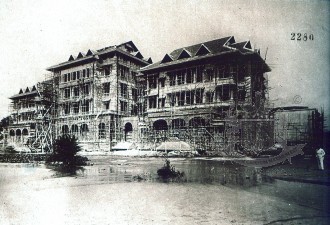
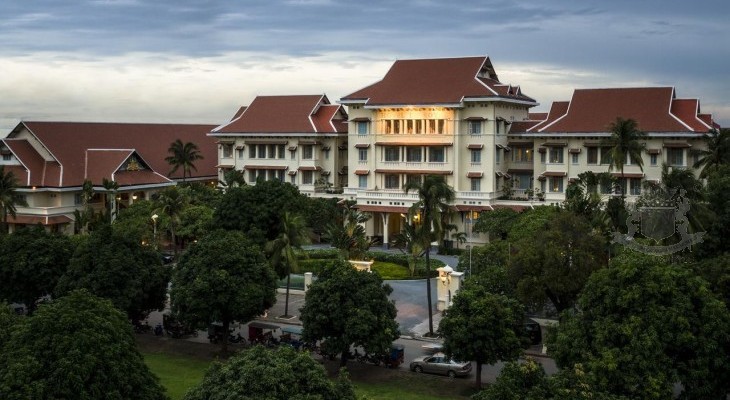
Le Royal under construction in 1928, and now.
Le Royal
In 1923/24, the construction of a 55-room hotel in Phnom Penh was proposed. Architect Ernest Hébrard, who was largely responsible for creating modern Phnom Penh, had his very own ideas about its construction
A visionary planner, he was in part responsible for turning this small, Cambodian/Royal—French/colonial city into a well-planned capital.
Under his directions, in 1928, the construction of the hotel commenced. It's style was a bold mixture of neo-classical European/Khmer. A solid base was topped by a lofty roof construction.
As Phnom Penh is home to the King of Cambodia and his Royal Palace, the hotel was aptly called Le Royal.

It finally opened in 1929 to accommodate passengers of steamship lines and air routes who were stopping off while travelling north-west to view the “long-lost Kingdom of Angkor.”
Le Royal became the hotel of choice for the Sultan of Johore (one of its first guests), screen idol Charlie Chaplin, British playwright Somerset Maugham, French statesman Charles de Gaulle, the widow Jacqueline Kennedy, French author (and thief of cultural artefacts) Andre Malraux and others.
Under the management of Raffles International, this grand historic hotel is a great base to experience the city. It's also your starting point to travel in style to the temples of Angkor, where an other famous hotel is waiting for you. It's younger sister, Grand Hôtel de l'Angkor.




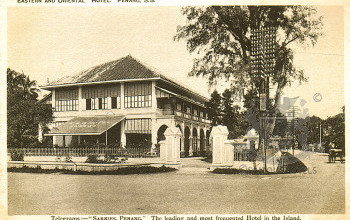
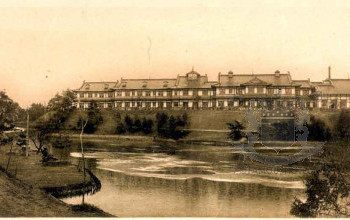
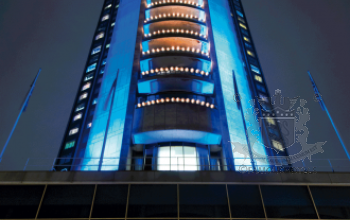

HISTORY IN BIREF:
In late 1923 and early 1924, the construction of a 55-room hotel in Phnom Penh was proposed, with Ernest Hébrard as architect. As visionary planner, he was in part responsible for turning a small, Cambodian-French colonial city into a well-planned and laid out city.
His initiall roposal also outlined construction of a 40 room hotel in Siem Reap and Hue and 12 and 8 room Bungalows in Panthiet and Djiring. It was the plan that the new hotel would be managed by the Society of Grand Hotels of Indochina. He combined French colonial style with traditional Khmer style.
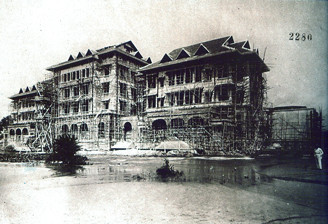
Hotel under construction in 1928
The Royal was designed with 54 rooms, 41 with with private bathrooms, 13 with showers only, and 4 with communal bathrooms.
1929: Le Royal opened. The official opening, attended by HM Sisiwath Monivong, took place on the evening of the 20 November 1929.
The Director between 1929 and 1931 was MLF de la Pousardiere followed by M Jean Baluteig.
1997: After a restoration and refurbishment programme, courtesy of Raffles International, the hotel reopened.
HISTORY:
The 1920s:
The plans to develop Phnom Penh are rooted in the growing popularity of South East Asia as a tourist destination. In late 1923 and early 1924, the construction of a 55-room hotel in Phnom Penh was proposed, with Ernest Hébrard as architect. A visionary planner, he was in part responsible for turning a small, Cambodian-French colonial city into a bustling well-planned metropolis.
The proposal also outlined construction of 40-room hotels in Siem Reap and Hué and 12 and 8-room bungalows in Phanthiet and Djiring, respectively. The tourist potential of the Angkor ruins did not pass unnoticed.
Included in the proposal were preliminary estimates for buildings and furnishings for the five sites. Costs were presented in the currency of Indochina (piastres). It is evident that the highest priority was given to the future hotel for Phnom Penh.
An integral part of Hébrard’s plan was to partially fill in a canal that encircled Phnom Penh’s European Quarter, plant extensive gardens, extend the city to the other side of the Tonle Sap River, create a new central market for the city and construct a new hotel to be managed by the Society for Grand Hotels of Indochina.
1929: A royal opening
The official opening, attended by His Majesty Sisiwath Monivong (reigned 1927-1941) and a host of expatriate guests took place on the evening of 20 November. The opening party included a lavish buffet, dancing, and performances by an orchestra brought especially from Saigon for the occasion. The Director of the hotel between 1929 and 1931 was M.L.F. de la Pousardière.
On 22 December 1931, L’Echo du Cambodge announced the departure of M La Pousardière and a new direction for Le Royal under the supervision of M. Jean Baluteig.
Today, the street immediately alongside the hotel bears the name of the King, boulevard Preah Monivong. The original name of the street in front of the hotel has changed several times through the course of years. Originally avenue du Maréchal Joffre, it became Pologne Street (street 92) and is now known as Rukhak Vithei Daun Penh.
1930s to 1960s: A Hotel at the Crossroad to History and Culture
On 1.1.1930, Sir Malcolm MacDonald arrived at the Le Royal, literally at the crossroads of Southeast Asia and French Indochina, and Phnom Penh was considered the obvious starting point for excursions to Angkor. He left us a detailed account of the hotel at the time.
During this period, tourists were able to travel to Phnom Penh by ship from Singapore via Bangkok followed by a car journey, or alternatively, could travel overland from Bangkok by rail or car. There was also a bus service from Saigon, or for wealthier tourists, the option of hiring a chauffeur-driven car.
The matinee idol Charlie Chaplin, accompanied by his co-star of ‘Modern Times’ Ms. Paulette Goddard, visited Phnom Penh in April 1936 on their way to Angkor. They stayed at the Le Royal with an entourage that included Paulette’s mother, Mrs. Goddard, and a Japanese valet and secretary.
In addition to the rooms on the upper floors of the main building there were some 30 bungalow rooms and 6 studios available. The bungalows were arranged to the sides and grouped across the rear of the property. Architect Henri Chatel was responsible for the extensions and improvements to the hotel between 1957 and 1958. He added the studio-bungalows, an outdoor restaurant called ‘Le Cyrène’ (The Water Nymph), swimming pool and terrace, and transformed the entrance hall and furnishings. The studio suites were 2-storey groups of rooms to the west and east of the main foyer (now Restaurant Le Royal and an arcade of hotel shops).
In 1966, Charles de Gaulle arrived. The French president predicted about the Vietnamese-American war that it could become one of the worst problems in history.
1970s to 1980s: A turbulent time
Buoyed by the Sihanoukist years, the early 1970s saw a boom in tourism that ended abruptly with the Lon Nol period (1970-75) and subsequent Pol Pot régime that came to power in April 1975 and ended in January 1979. During this time, Phnom Penh's leading hotel witnessed its darkest hours.
1990s to the present day: A new lease of life
The hotel regained a new lease of life when renovations began in May 1996 under the supervision of Raffles International Limited, lead by American Richard 'Dick' Helfer.
All bungalows surrounding the hotel were demolished and replaced by three new, more substantial wings. The main building was left intact and completely refurbished. The capacity and functions of the hotel were greatly increased and improved - a necessity for a premier hotel. Considerable care was taken to trace and identify as many of the original fittings and furnishings as possible, however, little remained. The hotel commissioned local traditional Khmer artist studio to create painted ceilings, decorative beaten copper crests and outdoor sculptures.
The original floor plan of the main building and the studio differs slightly from the hotel today. However, the configuration of guestrooms remains intact. Some walls, entrance doorways and areas have been changed to accommodate new features. The Conservatory, the elegant arched lobby area has, however, been carefully restored, rescued from lowered ceilings, bricked-in spaces and false partitions. Similar, two symmetrical octagonal ‘rotundas’ - north and south of the lobby, have been returned to their original understated domed splendour. Koh Say Wee, architect for the restoration uses term such as ‘architectural layering’ to describe the methodical process of slowly stripping away later modifications to the building.
In the west wing on the ground of the main building, a small bar was located in the octagonal rotunda immediately in front of the present restaurant and the original director’s office and reception area located to the rear of the lobby space (now the Conservatory). An old-fashioned openwork metal-cage lift is said to have operated in the same location as the present elevator - a 1931 advertisement mentions ‘ascenseurs’, presumably similar to the restored lift at Raffles Grand Hotel d’Angkor.
In the east wing on the ground floor, a door (now invisible behind a decorative cabinet) in the vicinity of the present reception desk led directly into a dining area - the ‘Elephant Bar’ of today. Following the construction of the three new courtyard wings, the hotel now boasts a total of 170 guestrooms and suites, almost four times the original capacity. The new wings approximate the now demolished bungalows, albeit on a much grander scale.
Inside the original building, black and white corridor floor tiles were faithfully copied and re-laid in the same configurations. A number of original claw-footed bathtubs were completely restored and incorporated with modern fittings. The glazed light well over the central entrance foyer was retained (originally illuminated by indirect light from a series of dormer windows, it has been partially covered by the present roofline and artificially lit). The grand wooden staircase was restored and remains much as it must have been when the hotel was first opened.
Landscape architects Belt Collins International are responsible for the magnificent garden that has carefully incorporated mature, existing native and ornamental trees and been extravagantly replanted to soften the horizontality of the main building and the enclosing courtyard wings. Two large trees at either end of the extensive rear garden, mature palms situated close to the hotel entrance and large decorative frangipanis are part of the original planting.
The hotel reopened after extensive renovations on 24 November 1997 as ‘Raffles Hotel Le Royal’, and is today going from strength to strength as Phnom Penh’s most prestigious hotel property.
Oliver Dudler
Alex Kassatly
Richard Schestak
170 rooms and suites. Rooms
Personal valet service, air conditioning, international direct dialling, two-line telephone, shaver outlet, hairdryer, in-room safe, mini bar/refrigerator, colour TV with remote control, satellite channels, Cable TV.
Personality Suites - named after people with a close connection to the hotel: Somerset Maugham, Jacqueline Kennedy, Charles de Gaulle and Andre Malraux. Landmark Suites Raffles Suites - named in honour of Sir Stamford Raffles Khmer Suite, Kambuya Suite, Angkor Suite, Cenla Suite
Located in the heart of the city Phnom Penh. Raffles Hotel Le Royal is on 20 minutes' drive from Pochentong International Airport and within easy access of the city's attractions like the Royal Palace, Central Market, Russian Market and National Artifacts Museum.
Le Royal Cafe Monivong Elephant Bar Writer's Bar The Empress Room Le Phnom Poolside Terrace
Amrita Spa Swimming pool